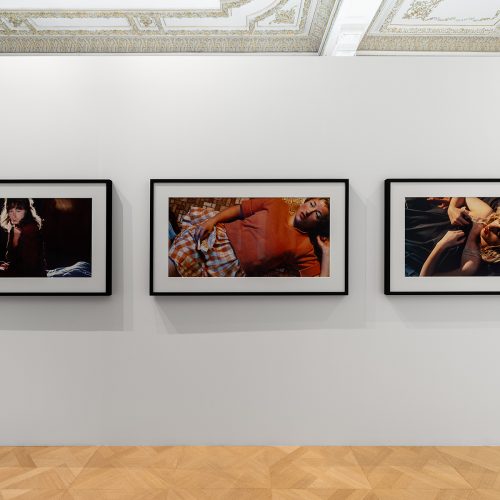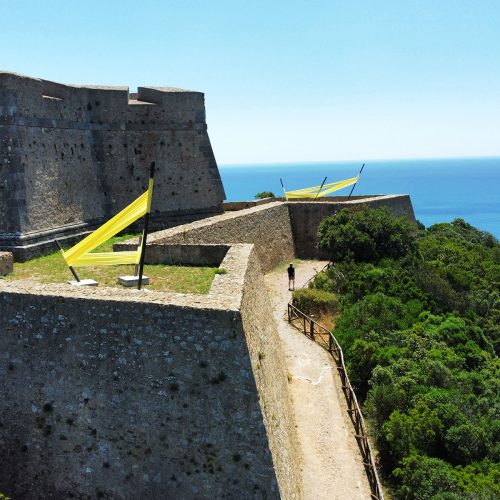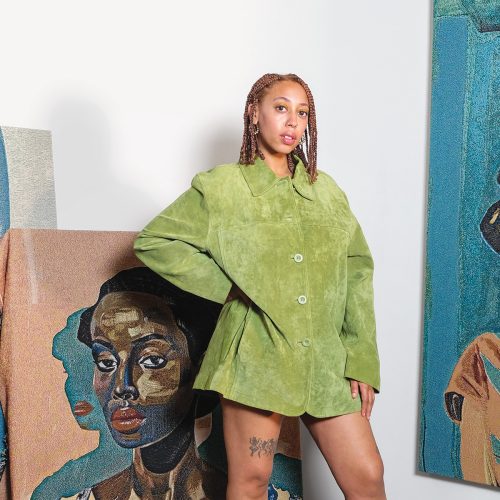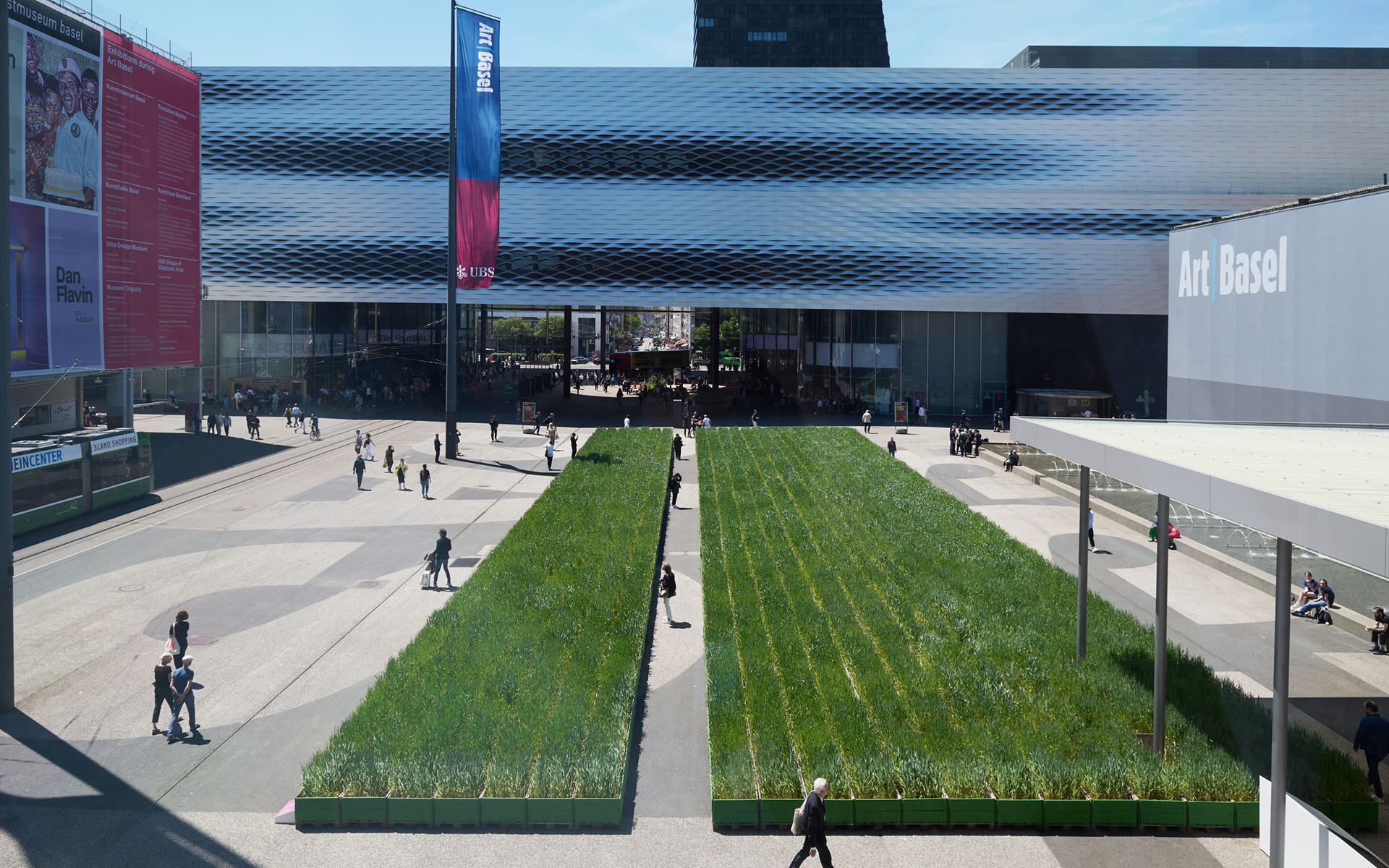

8 Standout Works from Art Basel 2024
From a recreation of Christo's Wrapped 1961 Volkswagen Beetle Saloon at Gagosian to Agnes Denes's transformation of the Messeplatz into a wheat field, these were the must-see artworks at this year's edition
Returning to the Messe Basel for the 2024 edition with 285 of the world’s leading galleries from 40 countries and territories, Art Basel in Basel is the most significant—and enjoyable art—fairs in the world.
Running through June 16, the expansive fair showcases an amazing array of major works by established and emerging artists, larger-than-life installations, cultural conversations, arthouse films, avant-garde performances and public art projects. There is no other creative platform that offers such an immediate overview of the current state of the arts and artistic production.

Art Basel in Basel 2024. Photo: Courtesy Art Basel
“We are witnessing a broadening of art collecting globally with new buyers entering the market and securing a baseline for business alongside our audiences that have continued to collect and are here in masses this week,” Art Basel CEO Noah Horowitz told Galerie on opening day. “At the same time, we recognize that the art market is undergoing a degree of recalibration, something that was charted in the Art Basel and UBS Art Market Report, which saw the market decline four percent last year from 2022. There’s a degree of caution in the market that was in evidence in the spring art events and auctions. But after the first few hours today—given the global audiences that have attended and the energy of the hall—I can say the market is very much still here and very strong.”
From Christo’s recreation of an early wrapped Volkswagen at Unlimited to a double-sided late Picasso drawing of odalisques and lovers at Ben Brown Fine Arts, these are the not-to-be-missed artworks at this year’s fair.
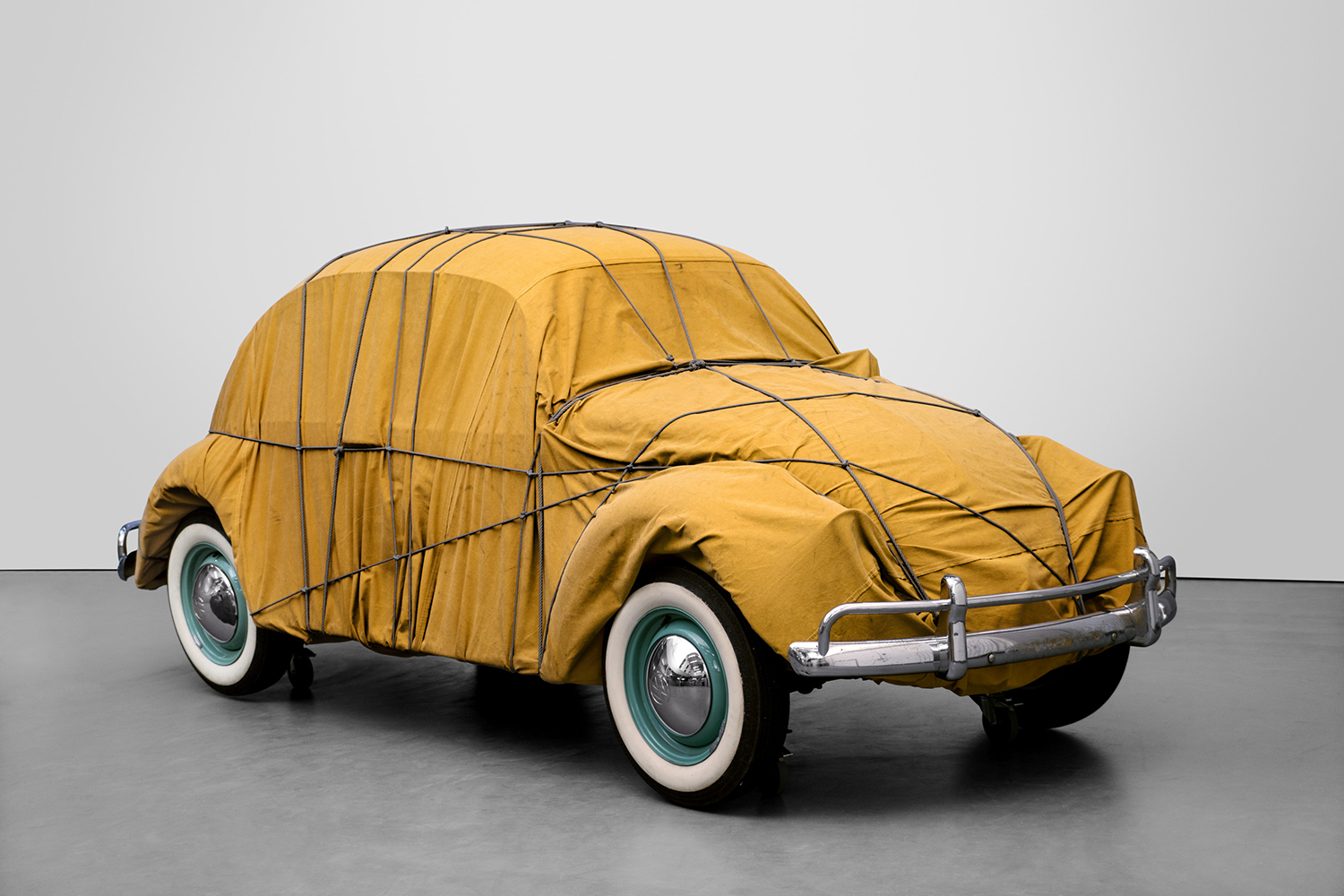
Christo, Wrapped 1961 Volkswagen Beetle Saloon, (1963–2014). Photo: Courtesy Gagosian
1. Christo at Unlimited (Presented by Gagosian)
A recreation of the original Wrapped 1961 Volkswagen Beetle Saloon, which Christo and Jeanne-Claude wrapped in February 1963 for Christo’s solo exhibition at Galerie Schmela in Düsseldorf, the new artwork, made by Christo in 2014, is the first thing visitors see when entering the Unlimited sector of the fair. Regretting that he wasn’t able to keep the first wrapped car, which he had borrowed from a friend of a friend to exhibit at Galerie Schmela, Christo purchased an identical model of the mint-blue 1961 Volkswagen Beetle in 2013 and soon returned the lost artwork to his body of work.

Joan Mitchell, Sunflowers, (1990-1991). Photo: Courtesy David Zwirner
2. Joan Mitchell at David Zwirner
A highlight of David Zwirner’s Art Basel booth—and one that sold on opening day—Joan Mitchell’s Sunflowers painting was one of the most memorable abstract canvases on view at this year’s fair. Painted in France in the last years of the artist’s life (she died in October 1992), the diptych is one of a small number of large-scale, multi-paneled canvases on the theme of sunflowers that the American expat created. Inspired by the artist’s admiration for Vincent van Gogh’s portrayal of the subject, Mitchell had endless amounts of sunflowers on her property in Vétheuil, France. They were a favored motif in her late paintings, providing the perfect subject for the lively colors and brushwork, which she so skillfully explored.

Sam Falls, Spring to Fall, (2023-24). Photo: Stefan Altenburger Photography, Zürich; Courtesy Galerie Eva Presenhuber, 303 Gallery, and Galleria Franco Noero.
3. Sam Falls at Unlimited (Galleria Franco Noero, 303 Gallery, and Galerie Eva Presenhuber)
Rendered outdoors over the course of a whole year in New York’s Hudson Valley, Sam Fall’s massive Spring to Fall painting is a sight to behold. Capturing the impression of local and native flora during the four seasons, the inventive artist placed the vegetation on an outspread canvas in a field and threw water-reactive pigments over the plants. Activated by the weather, the pigments created surreal silhouettes of the plants. Repeating the process in different seasons, Falls layered the passing flowers, stems, branches, and leaves to capture their short existence directly in the painting. Measuring some 66 feet in length, the colorful representation of nature was painted on a complete roll of 12-foot-high canvas—making it the largest work on view at the fair.

Iván Argote, Wild Flowers, Augustus: A Chest, (2024). Photo: Courtesy Perrotin
4. Iván Argote at Perrotin
Part of an installation with photographs of a replica of the Obelisco Flaminio floating above the Rome skyline for two days, which created the illusion of a possible relocation of the first obelisk brought to Europe by Emperor Augustus in 10 BC to celebrate the 20th anniversary of the conquest of Egypt, Wild Flowers, Augustus: A Chest is one of a series of surreal planters based on a statue of the conquering emperor. Sliced into pieces and used as holders for wild plants, the sculptures anticipate a future where nature reclaims and invades the remnants of statues erected in honor of “great historic men.” Related to the Colombia-born, Paris-based artist’s 2024 Venice Biennale sculpture of a toppled Christopher Columbus statue, which is a replica of the famous one in Madrid’s Plaza Colón, and other facsimiles of historic statues that he has turned to icons of the past, Argote’s work shows a path out of the hero worship of men who built nations on the backs of oppressed people.
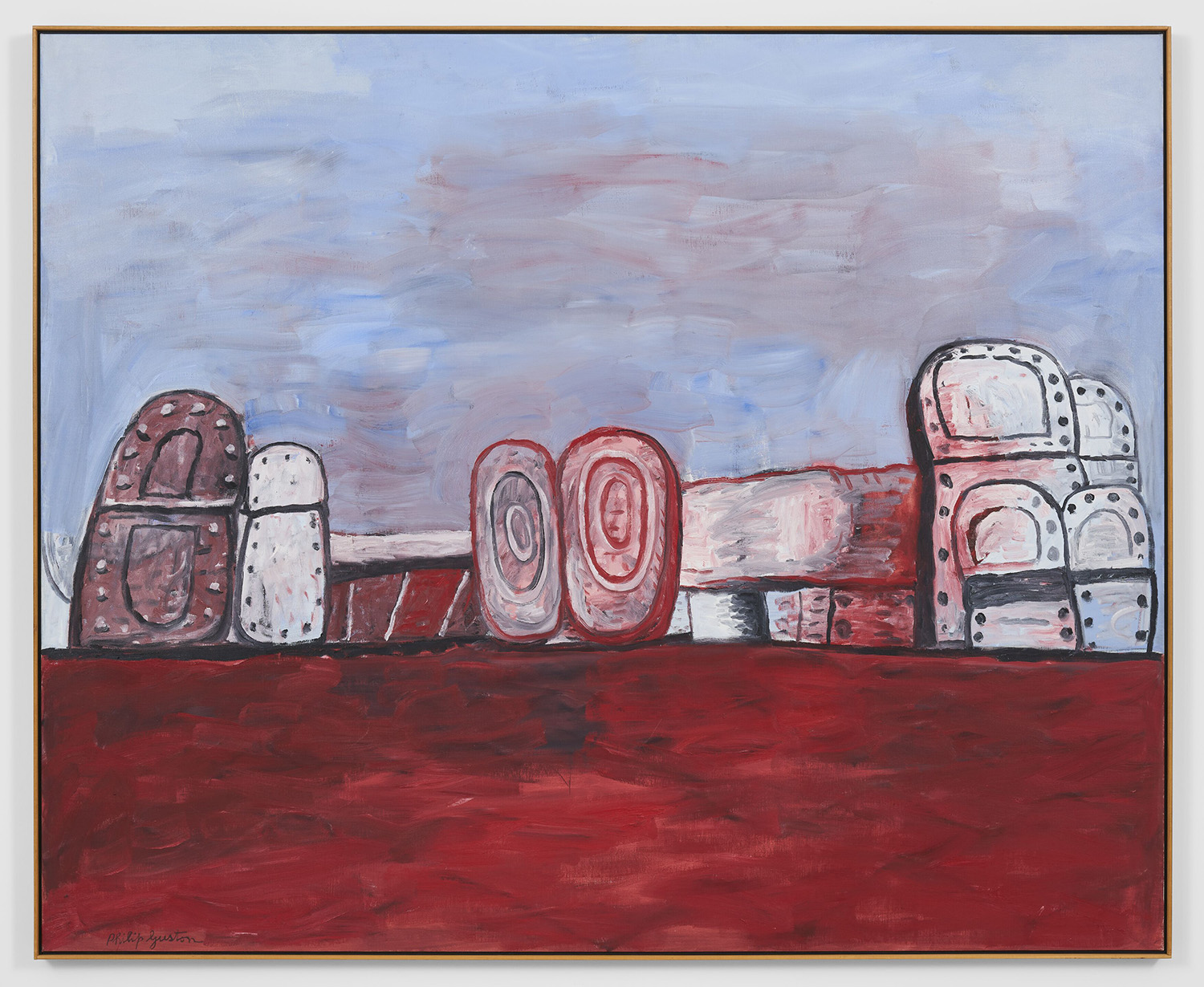
Philip Guston, Orders, (1978). Photo: Jon Etter; Courtesy the Estate and Hauser & Wirth
5. Philip Guston at Hauser & Wirth
An odd painting of shoes and shields from a series of late figurative works by Philip Guston, Orders seems to be a canvas that could have been on view in the gallery’s “Singularities” exhibition of the artist’s paintings from 1968 to 1979, currently on view at one of its Zurich locations. Curated in collaboration with Musa Mayer, the artist’s daughter and President of The Guston Foundation, the arresting solo show presents well-known paintings alongside never-before exhibited works that explore the freethinking motifs and intuitive forms that appeared in the artist’s late works as they continued to develop until his death in 1980. Depicting the heels of men’s shoes and garbage can lids that kids use as shields in mock battles in an abstract landscape, the painting marvelously carries the palette and mark-making of his Abstract Expressionist period of the 1950s into the later phase of his life.
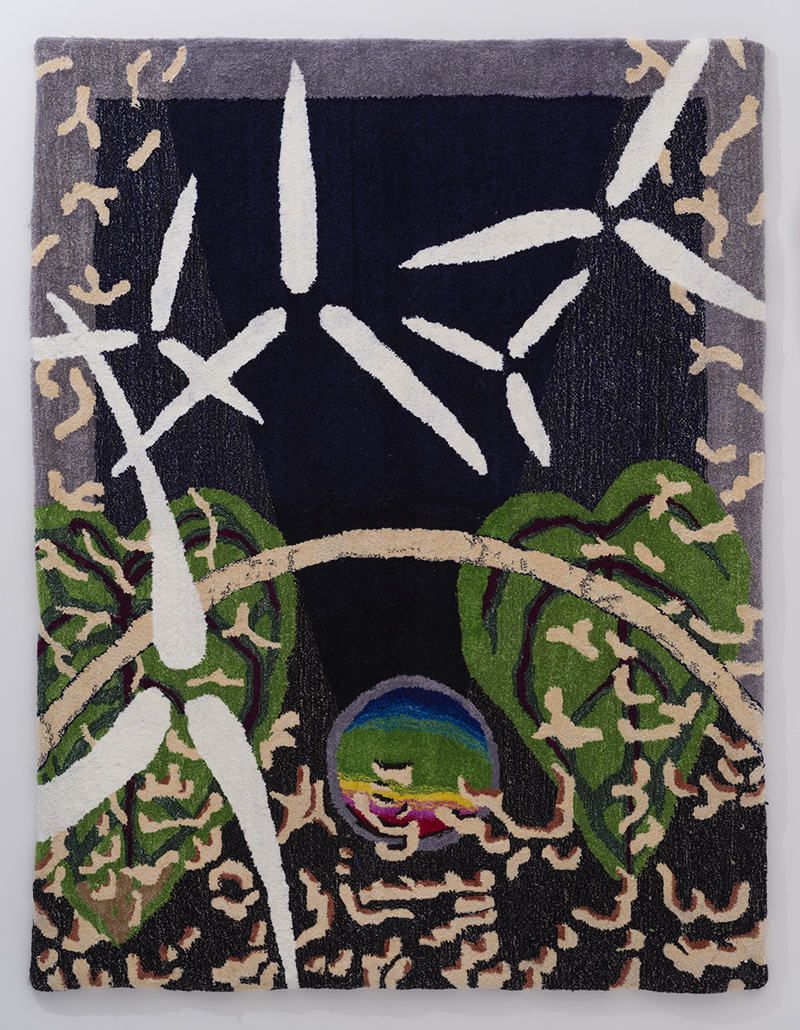
Yoko Daihara, Unnatural Scene, (2024). Photo: Courtesy Take Ninagawa
6. Yoko Daihara at Take Ninagawa
A self-taught artist who uses wool to convert drawings into colorful mindscapes with motifs from daily life, Yoko Daihara has found a new way to make a painting. One of a number of young artists who have turned to textiles to simulate paintings, Daihara makes digital drawings that reference nature and video games, which she turns into fiber artworks through the use of a tufting gun. A heavy tool that’s employed in the art of rug making, she uses it to shoot colored yarn into stretched cloth backing, which she then has to sheer to get a smoother surface. Using the automated tool like a paint brush to compose an image, the Tokyo-based artist creates lively landscapes that look natural yet are drawn from Daihara dreamlike visions of how she imagines nature should be.

Installation view, Agnes Denes, Honoring Wheatfield - A Confrontation, (2024) at Messeplatz Project. Photo: Courtesy Art Basel
7. Agnes Denes at Messeplatz Project (Presented by Art Basel)
Originally created in the summer of 1982 on two acres of landfill along the shores of New York’s Hudson River from the construction of the World Trade Center, Agnes Denes’ Wheatfield – A Confrontation: Battery Park Landfill, Downtown Manhattan was one of the first land art projects created in the city where mostly photos of the avant-garde medium were exhibited. Produced with a grant from the Public Art Fund, it was made with two hundred truckloads of dirt that was furrowed and cleared of rocks and garbage before being hand sewn by the artist, who later harvested over 1000 pounds of healthy, golden wheat, which traveled to 28 cities in “The International Art Show for the End of World Hunger.” Referencing the same issues of mismanagement, waste, world hunger and ecological concerns that existed in 1982, Honoring Wheatfield – A Confrontation on the Messeplatz in front of Art Basel will be harvested on the August 16, the same day as Denes’ first harvest, to continue the battle against the things that nature alone can’t control.

Pablo Picasso, Nu Couché au Miroir, Nu et Homme Couchés, (1969). Photo: Courtesy Ben Brown Fine Arts
8. Pablo Picasso at Ben Brown Fine Arts
A unique, double-sided pencil drawing created when Pablo Picasso was 90 years old, Nu Couché au Miroir, Nu et Homme Couchés (Lying Nude in the Mirror, Lying Nude and Man), from 1969, depicts his wife and muse, Jacqueline Roque, whom he married in 1961, as a reclining odalisque on the front side of sheet of painted paper and a young female embracing a man on the unpainted, reverse side of the paper. Drawn ten days apart in September of 1969, the sensual drawing of Jacqueline captures her gazing melancholically into a mirror while the equally erotic portrayal of the cuddling couple reveals the lovers resting after a sexual encounter, lost in their moment of reverie. Beautifully drawn with simple, sure lines, the two-sided drawing is a double delight, one that shows the aging artist as skillful as the young Picasso he was longing to once again be.


